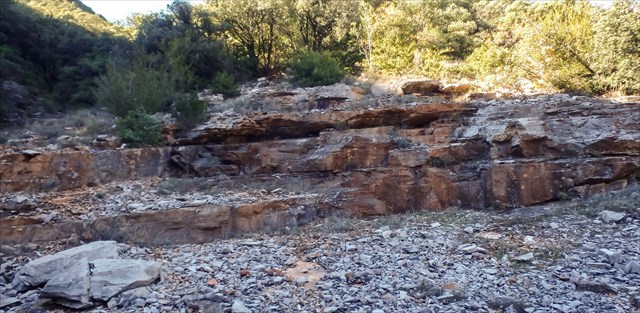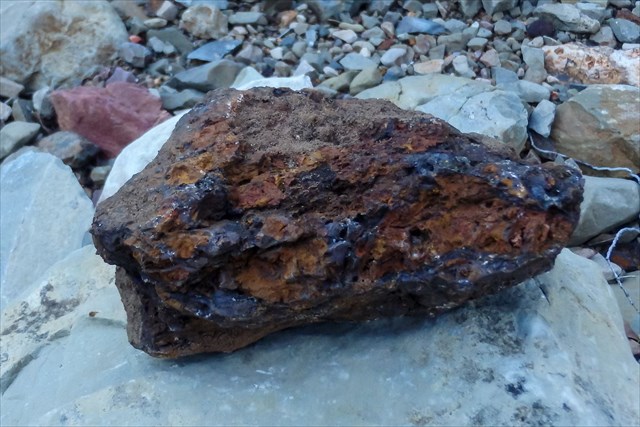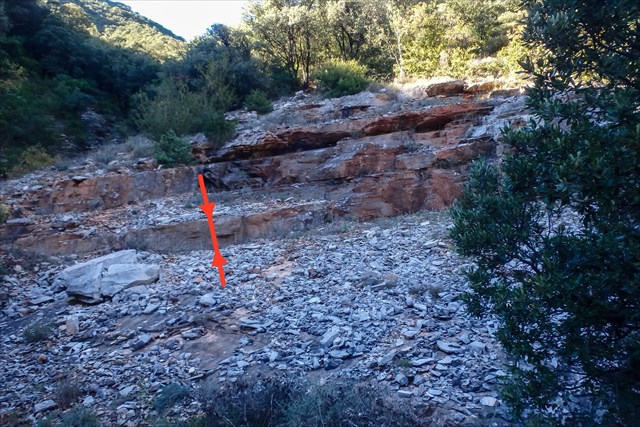

Situation géographique et historique
Le site tire son nom de l’ancienne installation minière avec deux fours contigus. En fait, en cherchant bien, on peut trouver d’autres fours bien cachés par la végétation sur la colline. On peut aussi trouver les restes de quelques cavités d’exploitation sommairement obstruées dans lesquelles il faut éviter de se promener à cause des risques d’effondrement.
Cette mine se trouve sur "les Jumeaux", à Sumène. Les minéraux présents étaient déjà exploités par les romains dès l’an 100 av J.C. Les restes de la mine actuelle datent de l'exploitation de 1828. Cette exploitation extrayait du fer, du zinc et du plomb.

Géologie
Minerais
Le minerai de fer est une roche contenant du fer, généralement sous la forme d'oxydes, comme l'hématite.
Les minerais de fer ont une teneur en fer variable selon le minéral ferrifère ; sachant également que l'isomorphisme, presque toujours présent dans les minéraux naturels, réduit la teneur théorique.
Les principaux minerais de fer sont des sulfures, des carbonates et des oxydes.
• Les sulfures, dont les représentants principaux sont la pyrite et la pyrrhotite, ne sont jamais utilisés directement pour la production du fer à cause de l'effet fragilisant du soufre sur les alliages ferreux. Ils constituent en revanche une matière primaire importante pour la production d'anhydride sulfureux, obtenu grâce au grillage. Il reste un résidu d'oxyde de fer ("cendres de pyrite") qui est pulvérulent et peut contenir encore des quantités gênantes de soufre : son utilisation comme minerai de fer peut donc se révéler problématique.
• Comme carbonate, on trouve la sidérite ou sidérose, FeCO3, qui donne l'oxyde par calcination. À l'air humide, la sidérite se transforme en lépidocrocite ou, plus rarement, en goethite. La sidérite est fréquemment associée à la pyrite, la magnésie, la chaux, le manganèse. On distingue le fer carbonaté spathique, minerai cristallin blanc, légèrement jaunâtre, très répandu, et la sphérosidérite, en masses sphéroïdales, mélangé à des matières terreuses, rare en France. Le minerai des gisements de houille renferme du charbon : il est de couleur noire et de grillage facile. Au Royaume-Uni, il est connu comme blackband.
La magnétite, spinelle ferrimagnétique Fe3O4, est le minéral de fer le plus riche en métal. Elle est souvent associée à l'hématite dans le même gîte, mais des gîtes de magnétite pure sont aussi connus. Densité 5.15, couleur noire, éclat métallique, souvent accompagnée d'impuretés comme la silice, la chaux, l'alumine et le phosphore.
L'hématite α-Fe2O3, est le composant le plus important des minéraux de fer traités dans l'industrie sidérurgique. Elle comporte plusieurs types :
• l'oligiste cristallise en rhomboèdres
• la spécularite consiste en agrégats de cristaux d'hématite à face lisse comme un miroir
• l'hématite rouge ordinaire se présente en masses fibreuses, terreuses ou compactes
• l'hématite rouge oolitique est formée de petites sphères agglomérées
• la martite est une hématite en pseudomorphose de la magnétite
La maghémite, γ-Fe2O3, est une forme métastable de l'hématite, α-Fe2O3, qui se forme à partir de la magnétite par oxydation progressive. Elle a les mêmes caractéristiques magnétiques que la magnétite, alors que l'hématite est faiblement magnétique. La structure est spinelle, mais avec des lacunes d'atomes de fer.
Les hydroxydes de fer se retrouvent mélangés, à l'état microcristallin, dans la limonite ou hématite brune et constituent le "chapeau de fer". Il s'agit d’un minerai d'origine sédimentaire qui contient de la goethite, de la lépidocrocite et en faibles quantités de l'hématite, des hydroxydes d'aluminium, de la silice colloïdale, des minéraux argileux, des phosphates, des arséniates, ainsi que des composés organiques. En masses fibreuses, la limonite est assez pure, mais lors qu’elle se présente en masses compactes ou terreuses, elle perd sa valeur sidérurgique, car elle contient des sulfures (de fer, mais aussi du plomb), des phosphates et arséniates. En France, il existe peu de limonite, mais on en trouve aux États-Unis, en Russie et en Scandinavie.
L'ilménite, minéral à structure d'hématite, est utilisée plutôt pour l'extraction du titane, le fer ayant un intérêt accessoire.
Les silicates ne sont pas utilisés pour l'extraction du fer, car le procédé d'enrichissement est complexe. De plus, sans traitement, ils sont incompatibles avec une utilisation dans un haut fourneau lorsqu'ils se présentent sous forme de sable car ils n'ont pas la perméabilité nécessaire pour laisser circuler les gaz réducteurs.
Minéraux
La teneur en fer des minéraux natifs est comprise entre des limites approximatives :
• minéraux magnétiques : Fe = 50% ÷ 67%
• minéraux d’hématite : Fe = 30% ÷ 65%
• minéraux de limonite : Fe = 25% ÷ 45%
• minéraux carbonates : Fe = 30% ÷ 40%
| Minéral |
Formule chimique |
Contenu théorique en fer dans le minéral |
Contenu théorique en fer après calcination |
| Hématite |
Fe2O3 |
69,96 % |
69,96 % |
| Magnétite |
Fe3O4 |
72,4 % |
72,4 % |
| Magnésioferrite |
MgOFe2O3 |
56 % - 65 % |
56 % - 65 % |
| Goethite |
Fe2O3H2O |
62,9 % |
70 % |
| Hydrogœthite |
3Fe2O34H2O |
60,9 % |
70 % |
| Limonite |
2Fe2O33H2O |
60 % |
70 % |
| Sidérite |
FeCO3 |
48,3 % |
70 % |
| Pyrite |
FeS2 |
46,6 % |
70 % |
| Pyrrhotite |
Fe1-xS |
61,5 % |
70 % |
| Ilménite |
FeTiO3 |
36,8 % |
36,8 % |
Ce que vous voyez :
Vous pouvez observer ici des strates et des roches de Limonite.
La limonite (également appelée aétite ou pierre à grelots) est un amas d’hydroxydes de fer microcristallin.
Cette roche sédimentaire contient de la goethite, de la lépidocrocite, des quantités mineures d'hématite, d'hydroxydes d'aluminium, de la silice colloïdale, des minéraux argileux, des phosphates, des arséniates ainsi que des composés organiques. Elle se forme par altération superficielle de plusieurs minéraux de fer, notamment sidérite, magnétite, pyrite.
La limonite est le principal composant du chapeau de fer. À une température supérieure à celle de la surface, elle peut perdre de l'eau et se transformer en hématite.
Cette pierre a un aspect noirâtre, mais devient jaunâtre lorsqu’elle est moulée. En sidérurgie, la limonite a peu de valeur, à cause de son contenu en phosphates et arséniates.

Pour valider la cache
-- Conformément aux guidelines de Groundspeak --
Envoyez-moi vos propositions de réponses soit via mon profil, soit via la messagerie geocaching (Message Center), PUIS loguez cette cache 'Found it'. Je vous contacterai en cas de problème.
Vu le nombre de logs que je reçois sans message, tout log posté sans avoir envoyé les réponses aux questions sera supprimé sans avertissement.
1. Quel type de minerai de fer est présent ici ? Quels en sont les caractéristiques ?
2. A quelle période a commencé l'exploitation du fer sur les Jumeaux ?
3. Quelle est la couleur des states présentes ici ?
4. Quelle est la taille de la strate du bas (voir photo) ?
5. [Optionnel] Une photo de vous et/ou de votre GPS sur le site (à inclure dans le log.)
|

Geographical and historical situation
The site takes its name from the old mining facility with two contiguous ovens. In fact, looking for good, you can find other ovens well hidden by the vegetation on the hill. We can also find the remains of some cavities of exploitation summarily obstructed in which one must avoid to walk because of the risks of collapse.
This mine is located on "Les Jumeaux" in Sumène. The minerals present were already exploited by the Romans as early as 100 BC. The remains of the current mine date from exploitation of 1828. This exploitation extracted iron, zinc and lead.

Geology
Ore
Iron ore is a rock containing iron, usually in the form of oxides like hematite.
The iron ores have an iron content varying according to the iron mineral ; knowing also that isomorphism, almost always present in natural minerals, reduces the theoretical content.
The main iron ores are sulphides, carbonates and oxides.
• Sulphides, the principal representatives of which are pyrite and pyrrhotite, are never used directly for the production of iron because of the brittle effect of sulfur on ferrous alloys. However, they are an important primary material for the production of sulphur dioxide, got through the fence. There remains a residue of iron oxide ( "pyrite ash") which is pulverulent and may still contain troublesome amounts of sulfur: its use as iron ore can be problematic.
• As carbonate, one finds siderite or siderosis, FeCO3, which gives the oxide by calcination. In humid air, the siderite turns into lepidocrocite or, more rarely, in goethite. The siderite is frequently associated with pyrite, magnesia, lime, manganese. A distinction is made between spatulate carbonate iron, white crystalline ore, slightly yellowish, very widespread, and spheroidal spheroidal mixed with earthy matter rare in France. The ore of coal deposits contains coal: it is black and easy to wire. In the UK, it is known as blackband.
Magnetite, ferrimagnetic spinel Fe3O4, is the iron mineral richest in metal. It is often associated with hematite in the same deposit, but deposits of pure magnetite are also known. Density 5.15, black, metallic shine, often accompanied by impurities such as silica, lime, alumina and phosphorus.
Hematite α-Fe2O3, is the most important component of iron minerals in the steel industry. There are several types:
• the oligist crystallizes into rhombohedra
• the specularite consists of aggregates of smooth-faced hematite crystals such as a mirror
• the ordinary red hematite occurs in fibrous, earthy or compact masses
• oolitique red hematite formed little agglomerated spheres
• the martite is a hematite in pseudomorphosis of magnetite
The Hematite, γ-Fe2O3, is a metastable form of hematite, α-Fe2O3, which is formed from magnetite by progressive oxidation. It has the same magnetic characteristics as magnetite, whereas the hematite is weakly magnetic. The structure is spinel, but with gaps in iron atoms.
The iron hydroxides are mixed, in a microcrystalline state, in limonite or brown hematite and constitute the "iron cap". It is an ore of sedimentary origin containing the goethite and lepidocrocite the amounts of hematite, the hydroxides of aluminium, colloidal silica, clay minerals, phosphates, the arseniates, and organic compounds. In fibrous masses, the limonite is quite pure, but as she comes in compact or earthy masses, it loses its steel value, because it contains sulphides (of iron and lead), phosphates and arseniates. In France, there are few limonite, but there are in the United States, Russia and Scandinavia.
Ilmenite, a mineral with a hematite structure, is used instead for the extraction of titanium, iron having an accessory interest.
Silicates are not used for iron extraction because the enrichment process is complex. Moreover, without treatment they are incompatible with use in a blast furnace when they are in the form of sand because they do not have the permeability necessary to allow the reducing gases to circulate.
Minerals
The native minerals iron content is between approximate limits:
• magnetic minerals : Fe = 50% ÷ 67%
• minerals of hematite : Fe = 30% ÷ 65%
• minerals of limonite : Fe = 25% ÷ 45%
• carbonate minerals : Fe = 30% ÷ 40%
| Mineral |
Chemical formula |
Theoretical iron in the mineral content |
Theoretical content in iron after calcination |
| Hematite |
Fe2O3 |
69,96 % |
69,96 % |
| Magnetite |
Fe3O4 |
72,4 % |
72,4 % |
| Magnesioferrite |
MgOFe2O3 |
56 % - 65 % |
56 % - 65 % |
| Goethite |
Fe2O3H2O |
62,9 % |
70 % |
| Hydrogœthite |
3Fe2O34H2O |
60,9 % |
70 % |
| Limonite |
2Fe2O33H2O |
60 % |
70 % |
| Siderite |
FeCO3 |
48,3 % |
70 % |
| Pyrite |
FeS2 |
46,6 % |
70 % |
| Pyrrhotite |
Fe1-xS |
61,5 % |
70 % |
| Ilmenite |
FeTiO3 |
36,8 % |
36,8 % |
What you see:
You can observe here strata and rocks of Limonite.
The limonite (also called aetite or stone to bells) is a cluster of microcrystalline iron hydroxides.
This sedimentary rock contains the goethite, of the lepidocrocite, minor amounts of hematite, of hydroxides of aluminium, colloidal silica, clay minerals, phosphates, arseniates and organic compounds. It is formed by superficial alteration of several iron minerals, including magnetite, siderite, pyrite.
Limonite is the main component of the iron cap. At a higher temperature than the surface, it can lose water and turn into hematite.
This stone has a blackish appearance, but becomes yellow when molded. In the iron and steel industry, limonite is of little value because of its phosphate and arsenate content.

To validate the cache
-- In accordance with Groundspeak guidelines --
Send me your suggested answers via my profile either via messaging geocaching (Message Center), THEN log this cache 'Found it'. I will contact you in case of problems.
Given the number of logs I receive without a message, any log posted without having sent the answers to the questions will be deleted without warning.
1. What type of iron ore is present here? What are the characteristics?
2. At what period began the exploitation of iron on les Jumeaux?
3. What is the color of the states present here?
4. What is the size of the bottom stratum (see photo) ?
5. [Optional] A picture of you and/or your GPS (to be included to the log)
|